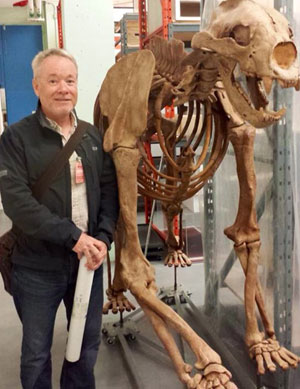UBC professor demonstrates why the landscape is a forever-changing fabric

UBC Assoc. Prof. Rob Young stands beside the skeleton of a short-faced bear, an extinct carnivore that is known as an ice age super predator. Young is giving a public lecture about post-dinosaur landscape erosion in the Alberta Badlands on October 15.
What: Post-dinosaur landscape evolution of the Western Interior
Who: UBC Assoc. Prof Rob Young
When: Wednesday, October 15, at 3:30 p.m.
Where: SCI 374, Science Building, 1177 Research Road, UBC’s Okanagan campus, Kelowna
When we drive across the prairies, the trip seems interminable and the landscape unchanging. Seeing statues and depictions of dinosaurs amongst the badlands of southern Alberta, there’s a great temptation to think that nothing has changed for a very long time.
UBC Assoc. Prof. Rob Young says if that’s what you think, then you’re wrong.
Young, who teaches in the Earth and Environmental Sciences & Physical Geography Unit in the Irving K. Barber School of Arts and Sciences, researches the vast changes the region has experienced since dinosaurs roamed the Earth.
Although the landscape suggests the scale of those changes, Young looks at the record of fluvial erosion, along with mammalian fossils incorporated into fluvial deposits, to help decipher the rates of landscape formation. There are indications that nearly a kilometre of sediment has been removed, at a rate that increased over the last several million years, and then slowed over the last two million years.
Mechanisms that explain some of the rate changes can be inferred, but some are only speculative. Join Young as he explains his research and why it’s important to keep track of changing landscapes.
Young’s presentation takes place Wednesday, October 15, at 3:30 p.m. in Room SCI 374, Science Building, 1177 Research Road on UBC’s campus. This event is part of the Irving K. Barber School of Arts and Sciences Unit 7 Seminar Series. It is free and open to the public. Pay parking is available on campus.
–30–